Flag of Gianatla (Pacifica)
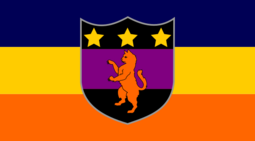 | |
| Use | National flag and ensign |
|---|---|
| Proportion | 3:5 |
| Adopted | 1 June 2016 |
| Design | A horizontal tricolour of blue, gold and orange with a variant of the Gianlucian coat of arms on top. |
The flag of Gianatla, nicknamed Einigkeitsflagge (unity flag), is a tricolour flag of three equally broad stripes of dark blue, gold and orange and contains an altered version of the Gianlucian coat of arms in its middle. The flag was adopted on the Gianlucian national day in 2016 replacing the old flags of Gianlucaland and Atlantis in an effort to bring the people groups of the Gianlucians and Atlantics closer together by representing both groups equally on the most important national symbol of the country.
Description
The current flag of Gianatla was introduced by King and Leader Gianluca IV in 2016 as a symbolic gesture towards the Atlantics, who were still not convinced yet the incorporation of Atlantis from 2011 was a step in the right direction for their country.
The design is based on three horizontal stripes of dark blue, so called "Atlantic blue", gold and orange.
The blue stands for the Atlantics, while the orange stands for the Gianlucians. The gold is representing the freedom both groups value highly. In its middle is an alternative version of the coat of arms of Gianatla with the Atlantic blue stripes being replaced by the traditional Gianlucian black stripes, which sandwhich a typically Atlantic violet stripe. In the upper black part are three golden stars, that represent the the Hazel Isle, the Gianlucian islands Eisern and Steenoog and the Gianlucian mainland respectively. Below of them is the national animal of Gianatla - the phoenix cat. This blazon shall represent the unity of the Gianlucians and Atlantics and led to the nickname "unity flag".
| Colour scheme | Atlantic Blue | Gold | Gianlucian Orange | Black | Royal violet | |||||
|---|---|---|---|---|---|---|---|---|---|---|
| RAL (Approximation) |
5022 Night blue |
1018 Zinc yellow |
2008 Bright red orange |
9005 Jet black |
4007 Purple violet | |||||
| CMYK | 100.100.0.67 | 0.20.100.0 | 0.60.100.0 | 0.0.0.100 | 20.100.0.67 | |||||
| Web color (HEX) | #000055 | #FFCC00 | #FF6600 | #000000 | #440055 | |||||
| RGB | 0,0,85 | 255,204,0 | 255,102,0 | 0,0,0 | 68,0,85 | |||||
Historic flags
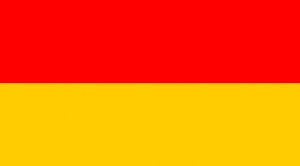
Gianlucian Kingdom (1305-1500s)
The first Gianlucian flag was found in depictions of Imperator Lucius I from the middle ages. Those show a bicolor consisting of two broad horizontal stripes in red and gold. The former seemed to have represented the blood lost to create the unity of the Gianlucian people while the latter was supposed to show a future of wealth and divine support. This is at least the interpretation given by 15th century chronologist Wilminus Backerus, that is still promoted by Gianlucian historians today.
A heavy usage of the flag by the public or even by the kings themselves outside of their abode can be safely outruled though as only the start of the age of exploration and colonialism marked the beginning of flags as a national symbol of identity in North Cordilia.
Gianlucian Empire (1500s-1935)
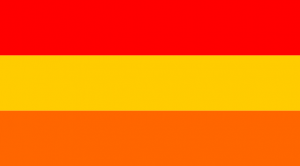
The age of exploration and colonialism has led to a sudden increase in territorial size for the relatively new nation. It is assumed, the change towards a tricolor, which included Gianlucian Orange for the first time, was due to symbolise the power of the Gianlucian court over its colonial possessions. However the addition of this particular stripe had yet another significance also. With Christianity being popularised by Austral merchants and missionaries in the empire, the church also tried to gain political power. The addition of another stripe with a colour directly connected to the court has shown the court's view of being equal in power to the Christian God as far as worldly affairs are concerned. Therefore especially among the clergy the introduction of the new flag in the 16th century was not very popular and even led to protests, which resulted in a limited persecution of priests, vicars and other people deeply believing in Christianity and other Abrahamic religions.
During the dictatorship (1935-1954)
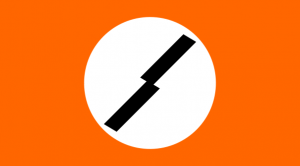
With the forced transfer of power from the Gianlucian court to Meinhard Frank on 2 May 1935, Frank abolished the imperial flag and replaced it with the one of his party. The flag did not have stripes anymore, instead it featured the orange much more prominently as a foundation for the entire flag. A white circle in the centre highlighted a symbol portraying a stylised lightning. Unlike the governments before, the Frankists enforced wherever possible and otherwise encouraged heavily the usage of the flag and the lightning symbol as another mean to solidify their ideology in the entire Gianlucian society. It went as far as that children in school and employees of the public sector had to pledge their allegiance to the flag on every school or work day by citing the Lightning Vow (Blitzschwur). The vow later evolved to become a short song supposed to keep up the morale of the general population as well as the troops abroad. The Song on the Flag would often get used as the closing theme of the daily news (Tagesrückblick) shown in cinemas throughout the country.
Republic of Gianlucaland (1954-2010)
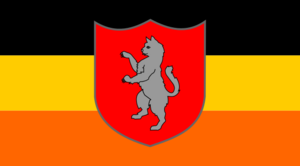
Queen Charlotte reintroduced a slightly different version of the imperial flag as a symbol of the traditional court returning onto the country's political landscape. With the new constitution, the Gianlucian Empire would reform to become a republic under the system of dictatorial democracy. The red moved into a new blazon in the centre of the flag, that contained a silver version of the Gianlucian national animal. The new black stripe as well as the cat stood for democracy and especially freedom after the tyrannical rule of Frank.
Atlantic flags until 2010
Flags of Atlantis historically contained purple as the colour of the royalty as well as one or two tridents. The tridents as well as the later introduced shades of blue in the Atlantic flags were portraying not only the supposed unlimited power of the king, but also stressed the reverence of the aquatic world. During the occupation of Atlantis in the Great War, the Frankists used a stylised trident in their flag for the Atlantic occupation zone, however the flag was barely used or promoted in comparison to the original counterpart of the Frankist party.




